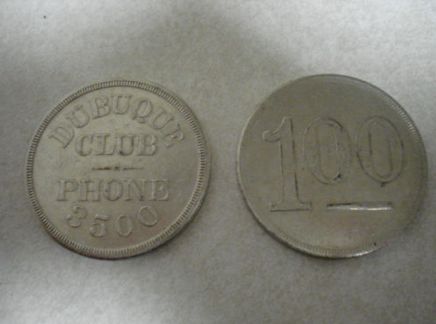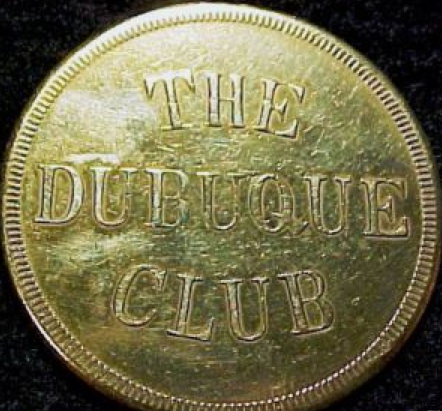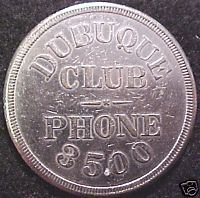Encyclopedia Dubuque
"Encyclopedia Dubuque is the online authority for all things Dubuque, written by the people who know the city best.”
Marshall Cohen—researcher and producer, CNN
Affiliated with the Local History Network of the State Historical Society of Iowa, and the Iowa Museum Association.
DUBUQUE CLUB: Difference between revisions
No edit summary |
No edit summary |
||
| Line 1: | Line 1: | ||
DUBUQUE CLUB. An early ancestor of the [[DUBUQUE AREA CHAMBER OF COMMERCE]], the Dubuque Club was established in February 1902 after the third attempt to establish a [[BOARD OF TRADE]] had failed. The first meeting occurred at the [[JULIEN HOTEL]] | DUBUQUE CLUB. An early ancestor of the [[DUBUQUE AREA CHAMBER OF COMMERCE]], the Dubuque Club was established in February 1902 after the third attempt to establish a [[BOARD OF TRADE]] had failed. The first meeting occurred at the [[JULIEN HOTEL]]. | ||
[[ | On April 23, 1903 President J. W. Conchar received the keys to the Dubuque Club Building at Ninth and Locust. The Dubuque Club occupied a lot upon which stood by a house belonging to Francis Gehon, one Dubuque's first settlers who operated a [[LEAD]] smelter with [[MCKNIGHT, Thomas|Thomas MCKNIGHT]]. The building was said to have been cut in half and moved from Peru, north of the city, to the Locust Street site. The Club torn down the house and had a building constructed costing an estimated $25,000 financed by the Key City Building Association. The Dubuque Club offered a library, kitchen, several large reception rooms, many meeting roons, a game room and a bowling alley. On June 2, 1903 President Theodore Roosevelt spoke to ninety-four members assembled around a large banquet table shaped like an "R" decorated with 6,000 carnations and 10,000 roses. | ||
[[Image:dubuqueclubdollar.jpg|left|thumb|250px|]]In the same year, the Club originated the idea of an excursion by train of Dubuque businessmen to other regions. Governor A. B. Cummins labeled this practice, the "Dubuque Idea". | |||
The second visiting trip of Dubuque Jobbers, Manufacturers, Bankers and Insurance and Freight Lines was considered a great success. The train included an eight-section compartment and observation car, a sixteen-section sleeper, a tourist sleeper for the band and a combination library and buffet car. Principal stops included West Union, McGregor, Lansing, Elkader, Waukon, Calmar, Oelwein, Decorah, Iowa and Austin and Hayfield, Minnesota. | The second visiting trip of Dubuque Jobbers, Manufacturers, Bankers and Insurance and Freight Lines was considered a great success. The train included an eight-section compartment and observation car, a sixteen-section sleeper, a tourist sleeper for the band and a combination library and buffet car. Principal stops included West Union, McGregor, Lansing, Elkader, Waukon, Calmar, Oelwein, Decorah, Iowa and Austin and Hayfield, Minnesota. | ||
Despite its successes, the Dubuque Club lacked unity and it was replaced by the | Despite its successes, the Dubuque Club lacked unity and it was replaced by the [[COMMERCIAL CLUB]]. | ||
[[Image:token1.png|left|thumb|250px|]] | [[Image:token1.png|left|thumb|250px|]] | ||
[[Image:token2.png|right|thumb|250px|]] | [[Image:token2.png|right|thumb|250px|]] | ||
Revision as of 02:44, 28 December 2011
DUBUQUE CLUB. An early ancestor of the DUBUQUE AREA CHAMBER OF COMMERCE, the Dubuque Club was established in February 1902 after the third attempt to establish a BOARD OF TRADE had failed. The first meeting occurred at the JULIEN HOTEL.
On April 23, 1903 President J. W. Conchar received the keys to the Dubuque Club Building at Ninth and Locust. The Dubuque Club occupied a lot upon which stood by a house belonging to Francis Gehon, one Dubuque's first settlers who operated a LEAD smelter with Thomas MCKNIGHT. The building was said to have been cut in half and moved from Peru, north of the city, to the Locust Street site. The Club torn down the house and had a building constructed costing an estimated $25,000 financed by the Key City Building Association. The Dubuque Club offered a library, kitchen, several large reception rooms, many meeting roons, a game room and a bowling alley. On June 2, 1903 President Theodore Roosevelt spoke to ninety-four members assembled around a large banquet table shaped like an "R" decorated with 6,000 carnations and 10,000 roses.
In the same year, the Club originated the idea of an excursion by train of Dubuque businessmen to other regions. Governor A. B. Cummins labeled this practice, the "Dubuque Idea".
The second visiting trip of Dubuque Jobbers, Manufacturers, Bankers and Insurance and Freight Lines was considered a great success. The train included an eight-section compartment and observation car, a sixteen-section sleeper, a tourist sleeper for the band and a combination library and buffet car. Principal stops included West Union, McGregor, Lansing, Elkader, Waukon, Calmar, Oelwein, Decorah, Iowa and Austin and Hayfield, Minnesota.
Despite its successes, the Dubuque Club lacked unity and it was replaced by the COMMERCIAL CLUB.
---
Source:
Pamphlet. "Dubuque Area Chamber of Commerce Annual Dinner Celebating Its 60th Anniversary March 31, 1976







